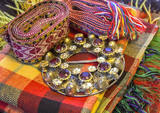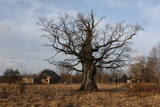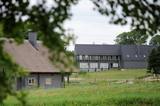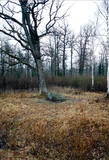| Nr | Name | Beschreibung |
|---|---|---|
|
Atrodas Riekstusalas pussalas galā. No tā labi pārskatāma aizaugušā Kaņiera ezera ziemeļu un austrumu daļa. Izcila putnu vērošanas vieta. Pie torņa atrodas viena no retajām Latvijas kadiķu audzēm. Turpat meklējams Kaņiera ezera niedru laipas (uz pontoniem) sākums. |
||
|
Das Zeitzentrum Wittenstein befindet sich im Turm auf dem Wallberg Paide. Das Zentrum ist wie eine Zeitmaschine, wo die Gäste aus einem Zeitalter in ein anderes mit einem Fahrstuhl getragen werden. In jedem Stockwerk werden unterschiedliche Zeitalter dargestellt: die Früh- und Ordenszeit, die Zeit der Könige und der Zaren, die Zeit der Okkupation sowie die Zeit der Wiedererlangung der Unabhängigkeit. Im Zeitzentrum gibt es viele Ton- und Lichteffekte, Videoprogramme und Illusionen. |
||
|
Features vivid woven Suiti textiles and offers master's classes. You can also purchase souvenirs. Contact the workshop in advance if you want to take part in the classes. |
||
|
Eine kleine Ortschaft mit einer Schule, einer Bibliothek und einem Geschäft. Nördlich von Vīdale kann man die Reste einer Windmühle besichtigen. Wenn man die Richtung Rigaer Bucht nimmt, kreuzt die Straße die Blauen Berge von Šlītere mit Sandsteinwänden und mit eindrucksvollen Aussichten in den Jahreszeiten, wenn die Bäume keine Blätter haben. Auf der linken Seite kann man die Quelle der Blauen Berge sehen, wo eine Stelle zum Wassernehmen eingerichtet ist. Die Straße, die von Vīdale nach Melnsils führt, nennen die Einheimischen den Damm Knipeldambis. Die Straße soll von der Deutschen Armee während des Ersten Weltkriegs gebaut worden sein, indem auf dem Weg Rundhölzer gelegt und mit Kies beschüttet wurden. |
||
|
Der Stein befindet sich südlich von Jēkabpils, am nordöstlichen Teil der Sand- und Kiesgrube (des Sees von Radži). Es ist interessant, das der Stein bei den Arbeiten in der Grube gefunden wurde. Der Stein von Radži wird als der zweitgrößte Stein in Lettland (das Volumen ~ 100 m3) gewertet. Im Norden der Kiesgrube befindet sich der Waldpark von Jēkabpils, der für die Einheimischen ein bekannter Ort für Erholung, Spaziergänge und Sport ist. Der Strand des Sees von Radži hat im Jahr 2012 die Blaue Fahne erhalten. |
||
|
Das Unternehmen „Rankas piens” wurde 1996 gegründet. Im Unternehmen werden ~ 80 verschiedene Milchverarbeitungsprodukte hergestellt: Käse, Quark, Sauermilchprodukte, Desserts u.a. Eines der fünf lettischen Unternehmen, das den weichen Kümmelkäse "Jāņu" herstellen darf, der als garantiert traditionelle Spezialiät in das EU-Register eingetragen ist. Die Produktion kann man in einem zum Unternehmen nahegelegenen Geschäft „Rīmaļnieks” kaufen. |
||
|
Found in the Alsunga Museum, the workshop has been open since 2009, showing people how various ceramics can be made from clay. Visitors can try their hand at the task or just watch as the clay is shaped, spun and, finally, glazed. |
||
|
Farm is located ~1 km to the north of Puikule near to the former Limbazi railway, in the territory of North Vidzeme Biosphere Reserve. The farm breeds sheep of the Latvian dark-head breed from which wool, hats, scarves, souvenirs etc. are made by felting. They can be purchased in the farm. Sheep graze in nearby meadows, thus promoting plant diversity in the area. About the role of pets in maintaining biodiversity can also be read on the bench in the yard. In the barn house is a collection of household items. Visitors can take a guided tour and buy souvenirs. |
||
|
The Krimulda Castle was built in the latter half of the 13th century. It was located where the right bank of the ancient Gauja River valley is split by the deep Vikmeste ravine. The castle was owned by the council of archbishops from Rīga, and it was an impressive structure with a large interior courtyard and a defensive wall that was 1.5 m thick. The Swedish military blew up the castle when retreating in 1601. Today the castle hill is forested, and only a small fragment of the castle wall can still be seen. It is near the ruins that you will find the Sigulda aerial tram and the Krimulda serpentine road – the only object of its kind in the Baltic States. |
||
|
This is the thickest European wild apple tree in Latvia. It is just lovely when it is blossoming.
|
||
|
Saimniece piedāvā sertificēta pirtnieka pakalpojums, organizē latviskos pirts rituālus, vada izglītojošas programmas par augu spēku izmantošanu savai labsajūtai. Apvienojot pirtnieka pakalpojumus un pašas ražoto produkciju, saimniece radījusi zīmolu - “Arnitas labsajūtu darbnīca”. Kā mājražotāja piedāvā pašceptu maizi, zāļu tējas un augu sīrupus, kā arī meistardarbnīcas kulinārā mantojuma jomā. |
||
|
Auf dem Mākoņkalns (Wolkenberg) befand sich die praktisch unbezwingbare Livonische Ordensburg – Burg Wolkenberg, eine der ersten Festungen in Latgale, von der bis heute allerdings nur Fragmente der Burgmauern erhalten sind. Der Legende nach wurden die weitläufigen Besitztümer nach dem Tod des Burgherren und dessen Frau unter deren drei Töchtern Rose, Luzia und Maria, aufgeteilt. Jede der Schwestern habe auf ihrem Erbe wieder eine Burg gebaut, Rose in Rēzekne (deutsch: Rositten), Luzia in Ludza (deutsch:Ludsen) und Maria in Viļaka (deutsch:Marienhausen). Am Fuß des Wolkenbergs befindet sich eine Tafel zum Gedenken an den Besuch des Staatspräsidenten der ersten freien Republik Lettlands im Jahre 1938. |
||
|
Lauku viensēta ar 8,9 ha lielu teritoriju atrodas Alītas rajonā, netālu no Simnas pilsētas pie gleznaina Atesio ezera Atesninki ciemā.100 m attālumā no ūdens ierīkots viesu nams ar 70 gultas vietām. Piemērota svinību un konferenču rīkošanai līdz 100 personām. Iespēja pašiem gatavot ēst, jo aprīkota ar plašu virtuvi. Lauku sēta radīta gan aktīvai, gan mierīgai atpūtai. Ir basketbola un volejbola laukumi, bērnu rotaļu laukums, dārzs, zvejas būdas, grilla vieta. Bezmaksas izmantojami 4 ūdens velosipēdi, kanoe vai koka laivas. Pirts patīkamai laika pavadīšanai. |
||
|
Die Route führt durch den Naturpark der Bogen von Daugava, den man in den 1980er Jahren überfluten wollte, indem man ein Wasserkraftwerk auf dem Fluss Daugava bauen wollte. Die zentrale Arterie des Naturparks ist das Urstromtal des Flusses Daugava. Eine Besonderheit von Daugava sind acht große Flusskurven – Bogen, die 4 – 6 km lang sind. Die Ufer des Flusses erreichen ihren höchsten Punkt in den sogenannten Toren von Daugava, wo der Fluss von den steilen und großen Abhängen von Ververi und Slutiški eingeschlossen wird. Mehr als die Hälfte des Gebiets sind Wälder, die für Wanderungen und Beobachtungen in der Natur, sowie für Sammeln von Beeren und Pilzen geeignet sind. Das Tal des Flusses Daugava ist floristisch gesehen eines der reichten Orte in Lettland: Hier kann man mehr als 800 Pflanzenarten treffen. Hier kann man ein multinationales Milieu mit lettgallischen, litauischen, polnischen, russischen und weißrussischen Traditionen und ihrem Erbe beobachten. Einer der von Touristen beliebtesten Orte ist das Dorf Slutiški, dem kein anderer Ort in Lettland ähnlich ist. Route information from Latvijas Lauku forums |
||
|
Ebenso kann man sich in der traditionellen Sauna mit Birkenquast abschlagen. Man kann beim Melken zuschauen und auch selbst versuchen zu melken, frisch gebackenes Brot und Brötchen kaufen, sowie die Spezialität des Hauses, Apfeltee. Man kann ein Familienzelt mieten, an verschiedenen landwirtschaftlichen Arbeiten teilnehmen und diese erlernen. Zudem kann man angeln und im Teich baden sowie sich im Bogenschießen üben, sowohl mit traditionellen als auch mit modernen Bögen. |
||
|
This territory was established to protect the lovely central section of the Neries River, local species, and Lithuania’s largest oak forest.
|
||
|
Die ältesten Informationen über die Quelle von Tirza stammen aus der Mitte des 18. Jh., aber die Quelle wurde schon viel früher verwendet. Nach Waschungen oder dem Wasserschöpfen wurde der Quelle geopfert. In der ersten Hälfte des 19. Jh. begannen der Baron von Tirza und die Kirche einenKampf gegen die heidnischen Traditionen, sie waren jedoch nicht sehr erfolgreich. Über der Quelle wurde eine Überdachung gebaut und noch heute kommen Menschen zur Quelle, um Wasser zu schöpfen. |
||
|
The tour takes through all three Baltic States – Lithuania, Latvia and Estonia. The route visits the capital cities and some of the most attractive cities and towns in Mid - Baltics. The tour starts in Vilnius, the capital city of Lithuania. Kaunas is the second largest Lithuanian city, standing at the confluence of the Nemunas and Neris Rivers. Riga, the capital city of Latvia, offers a variety of cultural experiences and entertainment. Sigulda is famous for its landscapes and medieval castles. Cēsis is one of the most charming towns in Latvia with many attractions ranging from medieval heritage to nice restaurants, exhibitions and festivals. Valmiera offers art galleries, museums, nature trails and Valmiermuža beer from the famous local brewery. Tartu in Estonia is a university town, with some very popular tourist attractions such as the interactive AHHAA science centre, the largest in Baltic countries. Finish the tour in Tallinn – the capital city of Estonia. Tourist information centres in cities and towns will help you with maps, information on sights, attractions and guided tours, food, shopping and public transport. |
||
|
Der Waldweg führt vom höchsten Punkt des Haanja-Hochlands hinunter. Der wichtigste Anblick auf dieser Route ist der Suur Munamägi Hügel - 318 m über dem Meeresspiegel. Der höchste Punkt des Baltikums mit seinem Aussichtsturm bietet seinen Besuchern einen herrlichen 50 km langen Blick auf die estnische Natur. Die 150 Jahre alten westlichen Taiga-Fichtenwälder wachsen an den Hängen von Suur-Munamägi. Weiter kreist der Weg um den südlichen Teil des Vaskna-Sees und führt weiter über kleine Landstraßen, die von einsamen Gehöften und kleinen Ansammlungen von Bauernhöfen umgeben sind. Die Route endet in einem kleinen Dorf, Tsiistre, wo sich das Leinenmuseum befindet. Das Museum verfügt über eine Sammlung von Volkswäsche. Flachs ist eine der ältesten Kulturpflanzen in Estland und vor einigen Jahrzehnten waren blaue Flachsfelder in Südestland ein häufiger Anblick. |
||
|
Landwirtschaftsbetrieb und Ferienhaus in der hügeligen Landschaft von Vidzeme, Cēsis 35 km. Hier werden biologisch zertifizierte Marmeladenbonbons aus Roggenbrot und mit anderen Geschmacksrichtungen hergestellt, Kastenroggenbrot gebacken, das Getränk Kwas aus Brot sowie Lebkuchenteig aus Roggenmehl zubereitet. Außerdem werden Schmuck und Kunsthandwerk gefertigt. Produkte können gekauft werden. |
||






























